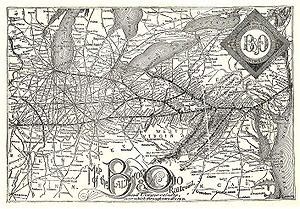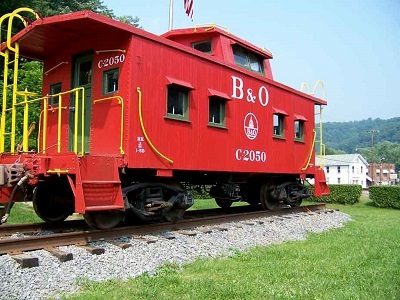The Baltimore and Ohio Rail Road Company, Americas first common carrier, was
chartered on February 28th 1827 by a group of Baltimore businessmen to ensure traffic would not be lost to the proposed
Chesapeake & Ohio canal. The early horse drawn rail lines were made of wood rails with iron straps laid upon the stone base. The first "official"
passengers rode in horse-drawn carts from Mount Clair in Baltimore to the Carrollton Viaduct being constructed on
January On May 24th the line was complete all the way to Ellicott's Mills, Md. The first trial run of Peter Cooper's Tom
Thumb in August of 1830 brought steam to the railroad along with many other improvements.
 Cast iron rails replaced
wood, trains of carts divided the weight upon the rails, flanged iron wheels held to the rail better than wood, and a braking
system was developed. The B&O expanded steadily with a branch reaching Washington in 1835. US Mail began flowing
on the line on January 1st 1838. The B&O reached Cumberland, Md. by June 1851, but to reach Wheeling, Va. (West Virginia
did not yet exist) 11 tunnels and 113 bridges had to be constructed. On June 22nd 1852 the line reached the Monongahela River
at Fairmont, Va. (now WV) and on Christmas Eve the last spike was laid east of Wheeling. On January 1st 1853 the first train
arrived in Wheeling from Baltimore in 16 hours, a trip that had once taken several days. The "West" was now open.
Cast iron rails replaced
wood, trains of carts divided the weight upon the rails, flanged iron wheels held to the rail better than wood, and a braking
system was developed. The B&O expanded steadily with a branch reaching Washington in 1835. US Mail began flowing
on the line on January 1st 1838. The B&O reached Cumberland, Md. by June 1851, but to reach Wheeling, Va. (West Virginia
did not yet exist) 11 tunnels and 113 bridges had to be constructed. On June 22nd 1852 the line reached the Monongahela River
at Fairmont, Va. (now WV) and on Christmas Eve the last spike was laid east of Wheeling. On January 1st 1853 the first train
arrived in Wheeling from Baltimore in 16 hours, a trip that had once taken several days. The "West" was now open.
The Baltimore & Ohio Railroad, helped determine the course of the war by
allowing the North to shuttle men to and from the Western and Eastern theaters and by bringing foodstuffs grown in the
Midwest to Federal armies in the East.
By 1861, the B&O stretched from Baltimore in the east to Wheeling, Va., and the Ohio River in the west. The B&O owned
more than 75 locomotives, 2,000 freight cars and in excess of 100 passenger cars.
At the beginning of the Civil War, the North and South both claimed the railroad.
The B&O presented two equally important problems to the Union and the Confederacy. Confederate President Jefferson Davis and
the Confederacy needed to maintain possession of the rail line's tracks in northwestern Virginia in order to prevent the capture
of strategically important Harpers Ferry.
The North wanted to keep the Confederates from controlling even a single mile of
track on the most important northern railroad extending west of the Appalachian Mountains.
The B&O got an early taste of the Civil War during John Brown's raid on the Federal armory in Harper's Ferry, West Virginia
(in those days still part of Virginia). Garrett learned that raiders had stopped a train at Harper's Ferry, and sent a telegraph to the
Secretary of War. Federal troops led by Robert E. Lee were sent to put down the rebellion on a B&O train. Garrett considered the
B&O to be a Southern railroad, and had pro-South sympathies. However, his business sense (and his anger at seeing Confederates
tearing up his railroad) made him side for the Union, and under his direction, the B&O
was instrumental in supporting the Federal government, as it was the main rail connection between Washington, DC and the northern states.
Knowing the importance of keeping the B & O Railroad safe and in the control of the
Union the protection and repair of the Baltimore and Ohio Railroad running from Washington to the Ohio River and further west
was placed in the very competent handsof the Sixth Regiment West Virginia Volunteers of the United States of America
The Sixth WV Inf. USA
Garrett was a confidant of President Lincoln, and often accompanied him on his visits
to battlefields in Maryland. In 1865 Garrett organized the funeral train that took the body of the assassinated president from Washington
to Springfield, Illinois, a trip which included stops and processions in Baltimore, Harrisburg, Philadelphia, New York City, Albany,
Buffalo, Cleveland, Columbus, Indianapolis, and Chicago.

After the Civil War travelers needed to no longer
go by foot, by horse, or wagon
to travel as far west as the Missouri River. Thus within just a few years thereafter railroads were
extended to the north west and to the California coast. Instead of months of travel
the movement from the east coast travel time was reduced to weeks and to some
distant places to just days.
